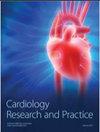Identification of Plasma Exosomes hsa_circ_0001360 and hsa_circ_0000038 as Key Biomarkers of Coronary Heart Disease
IF 1.8
4区 医学
Q3 CARDIAC & CARDIOVASCULAR SYSTEMS
引用次数: 0
Abstract
Background. Coronary heart disease (CHD) is the leading cause of death and disability worldwide. Accumulating evidence reveals that atherosclerosis (AS), characterized by systemic, chronic, and multifocal disease, and is the primary pathological basis of cardiovascular diseases, including CHD. However, the molecular underpinnings of CHD are still far from well understood. Our study attempted to identify aberrant plasma exosome-derived circRNAs and key exosomal circRNA biomarkers for CHD. Methods. The expression profiles of mRNAs, circRNAs, and lncRNAs in the blood exosomes of CHD patients and healthy controls were obtained from the exoRBase database. The corresponding miRNAs of the differentially expressed mRNAs, circRNAs, and lncRNAs were predicted via ENCORI and the miRcode database. LncRNAs/circRNAs and mRNAs with the cotargeted miRNAs were selected to construct an interaction network. Multiple machine learning algorithms have been used to explore potential biomarkers, followed by verification in patients with CHD using real-time quantitative reverse transcription-polymerase chain reaction (RT-qPCR). Results. Based on the cutoff criterion of , we identified 85 differentially expressed circRNAs (4 upregulated and 81 downregulated), 43 differentially expressed lncRNAs (24 upregulated and 19 downregulated), and 312 differentially expressed mRNAs (55 upregulated and 257 downregulated). Functional enrichment analysis revealed that the differentially expressed mRNAs were involved mainly in neutrophil extracellular trap (NET) formation and the nucleotide-binding oligomerization domain- (NOD-) like receptor signaling pathway. Further analysis revealed that the DEGs in the circRNA/lncRNA-miRNA-mRNA interaction network were closely related to lipid and atherosclerotic signaling pathways. Hsa_circ_0001360 and hsa_circ_0000038 were identified as potential biomarkers for CHD based on three machine learning algorithms. The relative expression levels of hsa_circ_0001360 and hsa_circ_0000038 were significantly altered in plasma exosomes from patients with CHD. ROC curve analysis revealed that the areas under the curve (AUCs) were 0.860, 0.870, and 0.940 for hsa_circ_0001360, hsa_circ_0000038, and the two-gene combination, respectively. Conclusion. The circRNA/lncRNA-miRNA-mRNA interaction network might help to elucidate the pathogenesis of CHD. Hsa_circ_0001360 combined with hsa_circ_0000038 might be an important diagnostic biomarker.鉴定血浆外泌体 hsa_circ_0001360 和 hsa_circ_0000038 作为冠心病的关键生物标记物
背景。冠心病(CHD)是导致全球死亡和残疾的主要原因。越来越多的证据表明,动脉粥样硬化(AS)以全身性、慢性和多灶性疾病为特征,是包括冠心病在内的心血管疾病的主要病理基础。然而,人们对冠心病的分子基础仍然知之甚少。我们的研究试图找出血浆外泌体衍生的异常 circRNAs 和 CHD 的关键外泌体 circRNA 生物标记物。方法。从 exoRBase 数据库中获取 CHD 患者和健康对照组血液外泌体中 mRNA、circRNA 和 lncRNA 的表达谱。通过 ENCORI 和 miRcode 数据库预测了差异表达的 mRNA、circRNA 和 lncRNA 的相应 miRNA。选择 LncRNAs/circRNAs 和与共靶 miRNAs 的 mRNAs 构建相互作用网络。使用多种机器学习算法探索潜在的生物标记物,然后使用实时定量反转录聚合酶链反应(RT-qPCR)在冠心病患者中进行验证。结果。根据Ⅳ的截止标准,我们发现了85个差异表达的circRNA(4个上调,81个下调)、43个差异表达的lncRNA(24个上调,19个下调)和312个差异表达的mRNA(55个上调,257个下调)。功能富集分析显示,差异表达的mRNA主要参与中性粒细胞胞外陷阱(NET)的形成和核苷酸结合寡聚化域(NOD)样受体信号通路。进一步分析发现,circRNA/lncRNA-miRNA-mRNA相互作用网络中的DEGs与脂质和动脉粥样硬化信号通路密切相关。根据三种机器学习算法,Hsa_circ_0001360和hsa_circ_0000038被确定为潜在的冠心病生物标志物。在冠心病患者的血浆外泌体中,hsa_circ_0001360和hsa_circ_0000038的相对表达水平发生了显著变化。ROC曲线分析显示,hsa_circ_0001360、hsa_circ_0000038和两个基因组合的曲线下面积(AUC)分别为0.860、0.870和0.940。结论circRNA/lncRNA-miRNA-mRNA相互作用网络可能有助于阐明冠心病的发病机制。Hsa_circ_0001360 与 hsa_circ_0000038 的结合可能是一种重要的诊断生物标志物。
本文章由计算机程序翻译,如有差异,请以英文原文为准。
求助全文
约1分钟内获得全文
求助全文
来源期刊

Cardiology Research and Practice
Medicine-Cardiology and Cardiovascular Medicine
CiteScore
4.40
自引率
0.00%
发文量
64
审稿时长
13 weeks
期刊介绍:
Cardiology Research and Practice is a peer-reviewed, Open Access journal that publishes original research articles, review articles, and clinical studies that focus on the diagnosis and treatment of cardiovascular disease. The journal welcomes submissions related to systemic hypertension, arrhythmia, congestive heart failure, valvular heart disease, vascular disease, congenital heart disease, and cardiomyopathy.
 求助内容:
求助内容: 应助结果提醒方式:
应助结果提醒方式:


